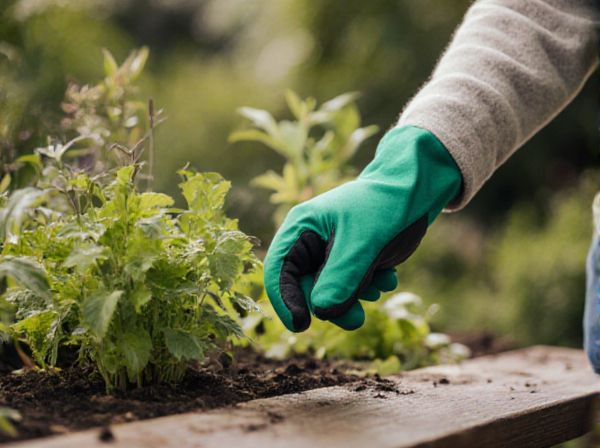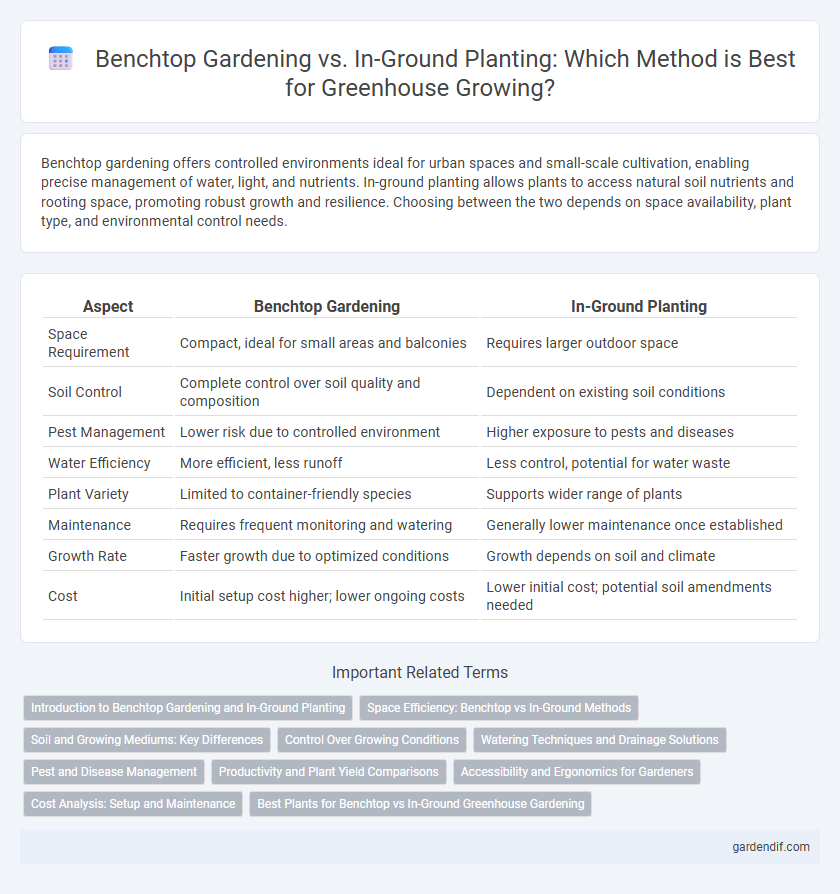
Benchtop gardening vs in-ground planting Illustration
Benchtop gardening offers controlled environments ideal for urban spaces and small-scale cultivation, enabling precise management of water, light, and nutrients. In-ground planting allows plants to access natural soil nutrients and rooting space, promoting robust growth and resilience. Choosing between the two depends on space availability, plant type, and environmental control needs.
Table of Comparison
| Aspect | Benchtop Gardening | In-Ground Planting |
|---|---|---|
| Space Requirement | Compact, ideal for small areas and balconies | Requires larger outdoor space |
| Soil Control | Complete control over soil quality and composition | Dependent on existing soil conditions |
| Pest Management | Lower risk due to controlled environment | Higher exposure to pests and diseases |
| Water Efficiency | More efficient, less runoff | Less control, potential for water waste |
| Plant Variety | Limited to container-friendly species | Supports wider range of plants |
| Maintenance | Requires frequent monitoring and watering | Generally lower maintenance once established |
| Growth Rate | Faster growth due to optimized conditions | Growth depends on soil and climate |
| Cost | Initial setup cost higher; lower ongoing costs | Lower initial cost; potential soil amendments needed |
Introduction to Benchtop Gardening and In-Ground Planting
Benchtop gardening offers a compact, controlled environment ideal for growing herbs and small plants using containers or trays, especially suited for limited spaces like balconies or greenhouses. In-ground planting utilizes natural soil, allowing deeper root growth and larger plants, beneficial for crops requiring more space and nutrients. Both methods vary in water retention, soil management, and plant selection, influencing yield and maintenance in greenhouse gardening.
Space Efficiency: Benchtop vs In-Ground Methods
Benchtop gardening maximizes space efficiency by utilizing vertical and compact areas within greenhouses, ideal for small-scale or urban settings. In-ground planting requires larger soil beds, making it less space-efficient but suitable for extensive crop varieties and root development. Choosing benchtop systems enhances controlled environment management while conserving floor space.
Soil and Growing Mediums: Key Differences
Benchtop gardening often utilizes soilless growing mediums such as coco coir, perlite, or peat moss to enhance drainage and nutrient control, whereas in-ground planting relies on natural soil rich in organic matter and microbial activity. Soil in in-ground planting provides a complex ecosystem that supports root development and nutrient cycling, while benchtop mediums offer a sterile and controlled environment ideal for seed starting or hydroponics. Understanding the distinct physical and chemical properties of these growing substrates is essential for optimizing plant health and yield in greenhouse cultivation.
Control Over Growing Conditions
Benchtop gardening in a greenhouse offers precise control over temperature, humidity, and light exposure, ensuring optimal conditions for delicate plants and rapid growth cycles. In-ground planting relies more on natural soil and environmental factors, which can limit the ability to regulate moisture levels and nutrient availability. This control advantage in benchtop gardening supports consistent crop quality and reduces the risk of pests and diseases.
Watering Techniques and Drainage Solutions
Benchtop gardening in greenhouses utilizes controlled watering techniques like drip irrigation and self-watering containers, optimizing water use and preventing over-saturation. In-ground planting relies on soil permeability and natural drainage, supplemented by raised beds and mulching to enhance water distribution and reduce runoff. Effective drainage solutions such as gravel layers and drainage channels ensure healthy root systems by preventing waterlogging in both methods.
Pest and Disease Management
Benchtop gardening in a greenhouse allows for better control over pest and disease management due to limited soil exposure and ease of monitoring, reducing the risk of contamination. In-ground planting often faces higher vulnerability to soil-borne pathogens and pests, requiring more intensive treatments and preventive measures. Effective integrated pest management (IPM) techniques tailored to each method significantly enhance plant health and yield.
Productivity and Plant Yield Comparisons
Benchtop gardening in a greenhouse offers higher productivity per square foot due to controlled environmental conditions that optimize light, temperature, and moisture, resulting in faster growth cycles and increased plant density. In-ground planting typically yields larger crops per plant because of deeper root access to nutrients and natural soil microbial activity, but often requires more space and is subject to external weather variations. Comparing both methods, benchtop gardening maximizes total yield in limited spaces, while in-ground planting benefits extensive growth and resilience for larger-scale production.
Accessibility and Ergonomics for Gardeners
Benchtop gardening offers enhanced accessibility by elevating plants to waist level, reducing the need for bending or kneeling, which benefits gardeners with mobility challenges or limited space. In-ground planting often requires prolonged stooping and can be less ergonomic, potentially causing strain during planting and maintenance. Ergonomic design in benchtop gardens enables easier reach and manipulation of plants, promoting healthier gardening habits and reducing physical discomfort.
Cost Analysis: Setup and Maintenance
Benchtop gardening requires lower initial investment with compact containers and limited soil needs, making it ideal for small spaces or urban environments, while in-ground planting demands higher setup costs including soil preparation and tools. Maintenance expenses for benchtop gardening are typically reduced due to controlled conditions and minimal water usage, whereas in-ground planting often incurs greater ongoing costs related to pest control, fertilization, and watering systems. Choosing between benchtop and in-ground options depends on budget constraints, available space, and long-term maintenance capacity.
Best Plants for Benchtop vs In-Ground Greenhouse Gardening
Herbs such as basil, parsley, and cilantro thrive in benchtop gardening due to their compact growth and preference for controlled environments. In-ground greenhouse gardening favors larger vegetables like tomatoes, cucumbers, and peppers that require deeper soil and more extensive root systems. Microgreens and lettuces perform well in benchtops, while root vegetables such as carrots and beets benefit from in-ground planting for optimal development.
Benchtop gardening vs in-ground planting Infographic

 gardendif.com
gardendif.com